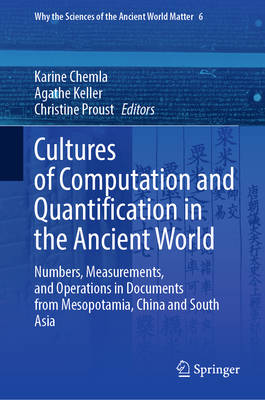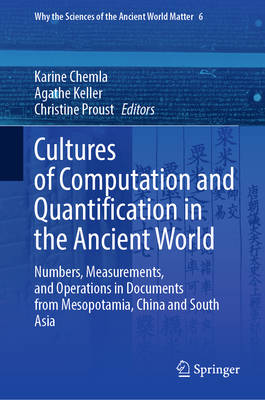
- Afhalen na 1 uur in een winkel met voorraad
- Gratis thuislevering in België vanaf € 30
- Ruim aanbod met 7 miljoen producten
- Afhalen na 1 uur in een winkel met voorraad
- Gratis thuislevering in België vanaf € 30
- Ruim aanbod met 7 miljoen producten
Zoeken
Cultures of Computation and Quantification in the Ancient World
Numbers, Measurements, and Operations in Documents from Mesopotamia, China and South Asia
€ 168,95
+ 337 punten
Omschrijving
Chapter 1. Cultures of computation and quantification in the ancient world: An introduction (Karine Chemla, in dialogue with Agathe Keller and Christine Proust).- Part 1: Shaping quantities and relating them to numbers.- Chapter 2. Carrying bricks and bundling reed in theory and practice (Wolfgang Heimpel).- Chapter 3. Measuring grain in early Bronze Age Mesopotamia: Form, use, and control of the bariga container in the Twenty-First Century BCE (Walther Sallaberger).- Chapter 4. Volume, brickage and capacity in old Babylonian mathematical texts from Southern Mesopotamia (Christine Proust).- Part 2: Interpreting numbers and quantities in texts.- Place value notations in the Ur III period: Marginal numbers in administrative texts (Ouyang Xiaoli and Christine Proust).- Chapter 6. The Nazbalum in old Babylonian Mesopotamia (Robert Middeke-Conlin).- Part 3. Working with operations and algorithms.- Chapter 7. Computing tools and representations of arithmetic (Baptiste Mélès).- Chapter 8. Working on and with division in early China, Third Century BCE-Seventh Century CE (Karine Chemla).- Chapter 9. Multiplying integers: On the diverse practices of medieval Sanskrit authors (Agathe Keller and Catherine Morice-Singh).- Part 4. Different cultures of computation and quantification.- Chapter 10. Another culture of computation from 7th century China (Zhu Yiwen).- Chapter 11. The characteristics of mathematical methods in the Wu Cao Suanjing and its social background (Zou Dahai and Chen Wei).- Chapter 12. Weighing units and weights in the context of trade between upper Mesopotamia and Anatolia (Nineteenth and Eighteenth Centuries BCE) (Cécile Michel).- Chapter 13. Quantification and computation in the mathematical texts of old Babylonian Diyala (Carlos Gonçalves).- Index.
Specificaties
Betrokkenen
- Uitgeverij:
Inhoud
- Aantal bladzijden:
- 765
- Taal:
- Engels
- Reeks:
- Reeksnummer:
- nr. 6
Eigenschappen
- Productcode (EAN):
- 9783030983604
- Verschijningsdatum:
- 2/01/2023
- Uitvoering:
- Hardcover
- Formaat:
- Genaaid
- Afmetingen:
- 156 mm x 234 mm
- Gewicht:
- 1251 g

Alleen bij Standaard Boekhandel
+ 337 punten op je klantenkaart van Standaard Boekhandel
Beoordelingen
We publiceren alleen reviews die voldoen aan de voorwaarden voor reviews. Bekijk onze voorwaarden voor reviews.










